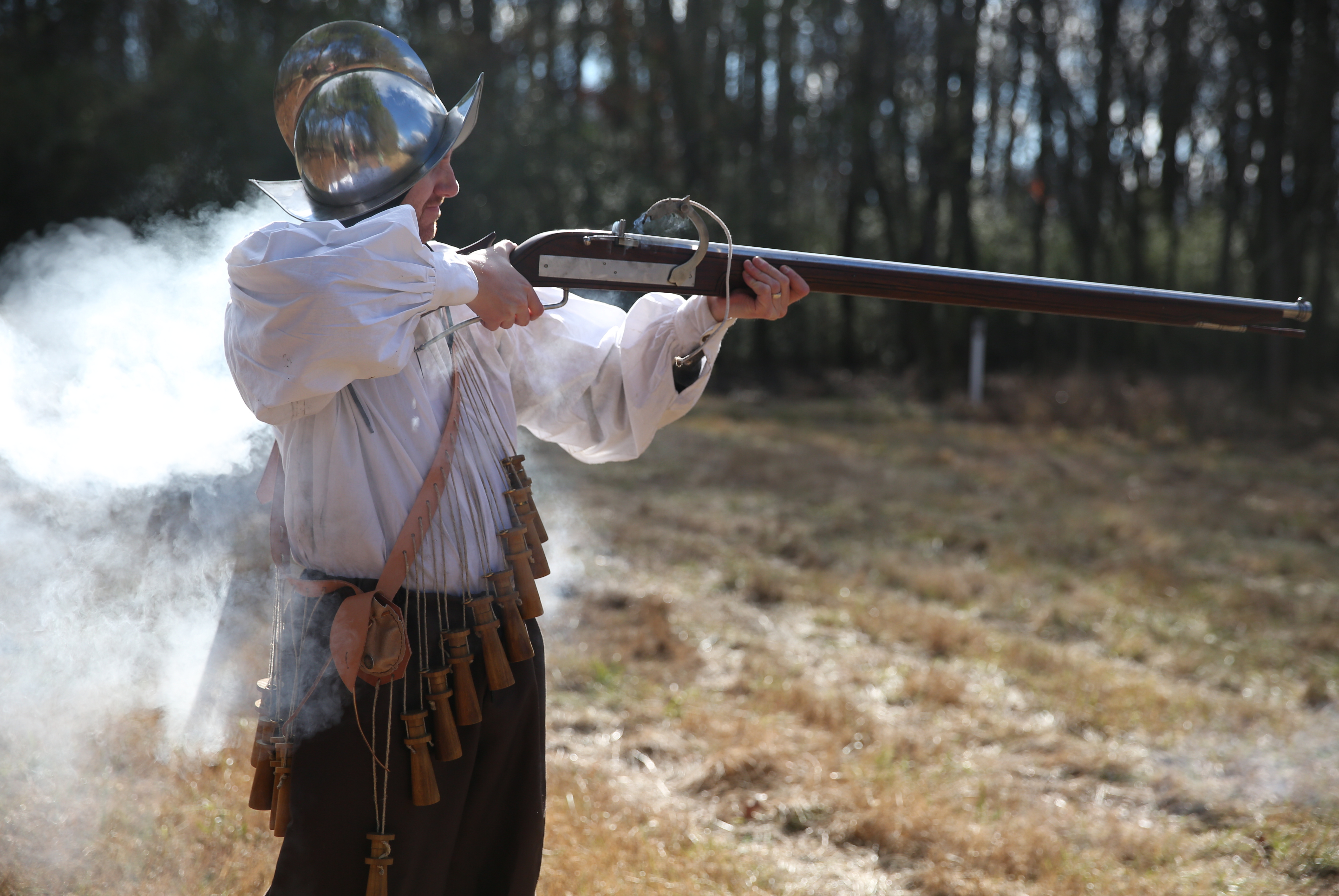Chris Young fired a new gun for the first time this week, one that could pass for a weapon made 500 years ago.
Young, a park ranger for Chickamauga and Chattanooga National Military Park, tried out the park's new arquebus, the kind of firearm that Spanish conquistadors carried when their expeditions brought them near Chattanooga sometime between 1540 and 1560.
"Fuego!" Young shouted, using the Spanish word for "fire" as the modern-day replica gun went off with a blast in the woods at the Moccasin Bend National Archaeological District.
Young dressed the part of a Spaniard set on plundering the New World for gold and glory.
He wore a heavy metal breastplate and shiny helmet called a morion, knee-high leather boots and a rapier, or slender sword meant for thrusting. Before he fired the gun, Young set aside the bulky armor and slipped on a bandoleer, or sash-style belt, that holds wooden gunpowder containers called "apostles," so-named because there are a dozen of them.
The get-up and the gun will help Young interpret, or explain, the Spanish conquistadors' role at Moccasin Bend, a peninsula on the Tennessee River near downtown Chattanooga that's been at the crossroads of history. The National Park Service acquired 750 acres on Moccasin Bend in 2003 and is offering programs about its history, including Indians' first appearance in 10,000 B.C., its role in the Trail of Tears and the Civil War.
"We have over 12,000 years of human history here," Jones said.
Moccasin Bend's soil has yielded Spanish beads and iron items, he said, that are either from Hernando de Soto's expedition to the American Southeast that began in 1539 or Tristán de Luna's 1559 expedition.
Conquistadors were brutal
It was a shock for American Indians when DeSoto's more than 600 conquistadors came, Jones said. They landed near Tallahassee, Fla., and journeyed through Georgia, the Carolinas, Tennessee, Alabama and Mississippi, Arkansas, Oklahoma, Louisiana and Texas.
It was the first time Indians had seen white men, horses, pigs, shiny armor, cannons and firearms, Cook said.
The conquistadors were brutal. They brought large dogs, mastiffs, that would attack on command, Jones said. The Europeans also spread disease, used Indians as slaves and caused starvation by eating stores of seed the agrarian Indians needed to grow the "three sisters" - crops of beans, corn and squash.
"De Soto set himself up as a God to these people," Jones said. When De Soto died in 1542 on the banks of the Mississippi, his men shrouded his body with blankets filled with sand and sank it to keep the ruse going.
While the smoke- and fire-spewing arquebus contributed to Indians' belief that De Soto was an immortal sun god, the weapon looks archaic today.
It uses a matchlock, a trigger-like lever that holds a lit fuse made of rope. A slow squeeze to the lever lowers the fuse into a primer pan full of gunpowder, causing the gun to fire.
The arquebus isn't especially accurate. The inside of the barrel isn't rifled like a modern-day gun.
"I always tell schoolkids to think about smooth bores like [shooting] spit-wads," Cook said.
The arquebus that the conquistadors carried mainly scared Indians, Cook said. Conquistadors' crossbows were more effective at killing.
The co-owner of an Oklahoma company that makes and sell arquebus replicas was more bullish on them.
"I've seen them outshoot flintlocks, once you get used to how they work," said Jess Melot of The Rifle Shoppe, Inc., in Jones, Okla. "We've got people that actually hunt with them."
The Fuller Gun Collection on display at Chickamauga Battlefield has two arquebuses on display among its roughly 350 firearms.
It may be a while before the public gets to see the park's new arquebus in action. Check the park's website for details.
Jones stills need to prepare an interpretive program about the conquistadors.
"I know people love to see the gun fire, but there's a lot more to it than shooting a gun," Jones said. "It's much more important to connect people to the place."
Contact staff writer Tim Omarzu at tomarzu@timesfreepress.com or 423-757-6651.

